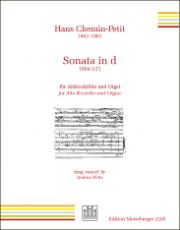Baroque role models
A recorder sonata at the limits, but always within the tonal framework.

Four fortunate family circumstances were involved in the creation of this Sonata in d for alto recorder and organ: Hans Chemin-Petit originally wrote the middle movement of the sonata in 1963 for the christening of his grandson Hajo - a cheerful, idyllic aria in three-four time with a calm andante tempo at the beginning and end and a somewhat faster middle section. The fact that he composed for recorder at all in the first half of the 20th century is due to the fact that one of his daughters - Jeannette Chemin-Petit - was a recorder player, first as a pupil of Linde Höffer-von Winterfeld, then as a professor herself in Berlin. And the third fact can be found in Hans Chemin-Petit's own biography: Born in Potsdam in 1902, the son of a bandmaster and a singer, he enjoyed piano and cello lessons from an early age, later studied cello and composition at the Musikhochschule in Berlin and rose to prominence both as a cellist and choral conductor, but also as a composer. His extensive oeuvre encompasses almost all genres and includes numerous works for recorder, from small-scale house music to a large double concerto for recorder, harpsichord, strings and percussion. However, Chemin-Petit also had to put up with critical questions: As a member of the Nazi Altherrenbund, he was committed to an ideology that casts him, his works and his work in an ambivalent light. For example, his cantata To love performed at the Reichsmusiktag 1938.
Hans Chemin-Petit explores in his Sonata in d As in his works in general, he explores the boundaries of tonality, to which he always remains attached. His thinking is also formally indebted to tradition: Both the understanding of form based on symmetry, the artful polyphony trained on J. S. Bach, the type of rhythm and the movement models (aria, gigue) refer to baroque models, but have been given a new guise thanks to Chemin-Petit's very personal tonal language and melodic richness. The two instruments, alto recorder and organ, are equal partners in the dialog.
In the summer after the aforementioned baptism, the composer added the two outer movements Allegro and Gigue to the first Aria to create a three-movement sonata in the classical style. We have his second daughter (and mother of the christened child) Andrea Witte to thank for the fact that it was edited at all - stroke of luck number four.
Hans Chemin-Petit (1902-1981), Sonata in d for treble recorder and organ, edited by Andrea Witte, EM 2165, € 15.00, Edition Merseburger, Kassel 2013








